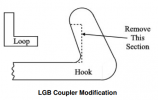Greg Elmassian
Guest
I realized that what I was trying to say was not well said, I meant to say will it be in a switchyard where coupling and uncoupling is de rigueur, or where trains are mainly running "through"... so I would guess the loops would normally be "through"?
Were the passive ones cheap? Did you two different brands/makes?
Greg
Were the passive ones cheap? Did you two different brands/makes?
Greg


